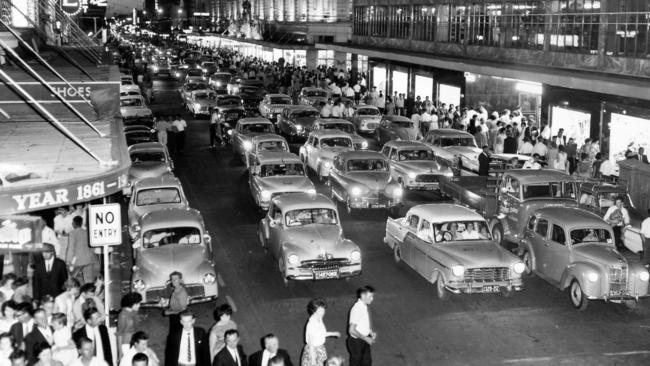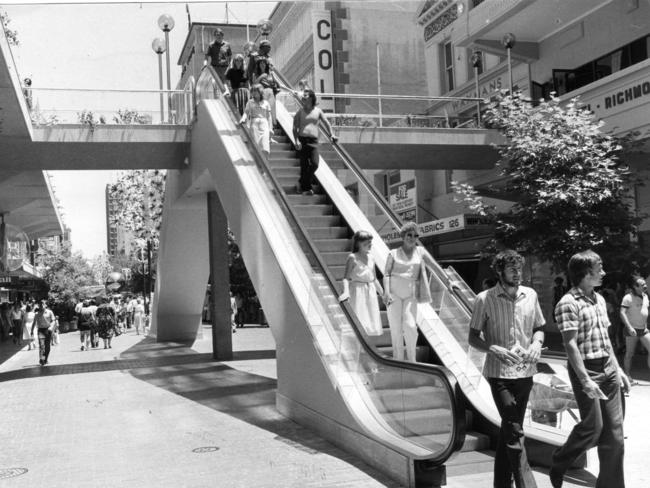How Adelaide got Rundle Mall
BEFORE the Balls, a shopping trip into town used to mean dodging the chaotic Rundle St traffic. Here’s how Rundle Mall was born.

SA News
Don't miss out on the headlines from SA News. Followed categories will be added to My News.
- What school was like in Adelaide in the 1950s and 60s
- When Chrylsers were made in Adelaide
- Derek Jolly and the Futuro, North Adelaide’s flying saucer house
BEFORE it was made into a pedestrian mall in 1976, Rundle St was one of the busiest, noisiest and most crowded commercial and retail shopping strips in Australia.
Many of our Boomer readers will recall in the 1950s, ’60s and early ’70s, the crush of pedestrians at traffic lights before and after work, the double-decker trolley buses as they wove their way up and down the street, cars, delivery vans, trucks, cyclists, the odd horse and cart and pedestrians spilling over from the crowded footpaths, forced to walk on the roadway among the slow-moving traffic.
The street has been the retail heart of Adelaide since the 1880s. It was included in Colonel William Light’s original plan for the city, when the streets and squares were first named in 1837 by the Street Naming Committee.

Rundle St was named after John Rundle, who was a successful businessman, British MP and a director of the South Australian Company (formed in London in 1835 to establish a new colony in SA).
By the early 1900s, Rundle St had established itself as the city’s prime retail location, with buildings like the Adelaide Arcade (1885), Harris Scarfe & Co (1884), J. Marshall & Co (1886), John Martins (1889), Birks Department Store (1880s), and Foy & Gibson (1907).

It was the main shopping hub during the day, and by the 1920s, it had also become the centre of theatre and cinema in the evenings.
In 1912, the Pavilion Theatre — later known as the Rex — was erected, the Grand Picture Theatre in 1916 (later called the Sturt), The York Theatre in 1921 and the grandest of them all, the Regent, which opened in 1928.
Over the next three decades, the traffic build-up intensified until, in the early ’60s, Adelaide City Council and leading businesses embarked on an ambitious strategy to transform the city.
It began with a modernisation plan and the widening of Gawler Place by demolishing the York Theatre in 1961.


This was before the era of the suburban shopping centres and any really serious shopping required a trip by car, tram, train or bus into the city centre. On a daily basis, thousands of people flocked to the major department stores and shops, while many more thousands travelled in for work. The result was mass congestion in Rundle St, and by the early ’70s it was clear that something further needed to be done.
It was in November 1972 that Premier Don Dunstan first proposed Rundle St be closed to all traffic between King William and Pulteney streets and turned into a pedestrian mall. There was much heated debate at the time, some traders fearing that it would see the end of the street’s dominance as Adelaide’s major shopping centre.


However, common sense prevailed and construction of Rundle Mall started in 1975 with the official opening taking place on September 1, 1976.
The opening was described by The News, Adelaide’s afternoon newspaper at the time, as a “champagne occasion”, with thousands turning out on the day for the official commissioning.
“After his arrival in a horse-drawn carriage and opening speech in the heart of the Mall, Mr Dunstan pressed a button and champagne flowed from an antique fountain at the Gawler Place corner.
The cheering crowd was quick to join in the festivities, some scooping up the golden brew to drink while the Police Band thumped out The Night They Invented Champagne.”



The traffic-free Mall proved an instant hit, with the big department retailers initiating further renovations and development to reinvigorate shopping in the heart of the city.
John Martin’s extended its store while both David Jones and Myer refurbished their premises. The council set out to attract more people to the Mall by investing in major artworks, including sculptor Bert Flugelman’s Spheres (better known as the “Mall’s Balls” or “Bert’s Balls”).

Since the opening in 1976, there have been many changes to the Mall, some good and, judging by the reaction of shoppers and commentators at times, some not so good.
In the 1990s, there was a big makeover that saw new paving and seating, and the well-established trees removed and replaced by smaller trees.
A little later, more sculptures were added: a set of bronze pigs by artist Marguerite Derricourt, titled A Day Out. Major changes also occurred when the Myer store was demolished, the new REMM Centre went up in 1991 and the much-loved John Martin’s store was demolished to make way for the new David Jones.

There have been further modifications in the past few years, with more changes to the pavers, seating, lighting, trees (again) and some attempts to revive the Mall after dark.
I like to think back to those years when it was almost impossible to move on the footpath, when the fumes from the traffic were overpowering, when Johnnies ruled supreme, when the Regent was the most glamorous picture theatre in Australia and when Adelaide’s retail heart was visibly thumping. What are some of your memories of Rundle St and Rundle Mall?
Bob Byrne is the author of Adelaide Remember When and posts memories of Adelaide every day on Facebook.com/AdelaideRememberWhen


